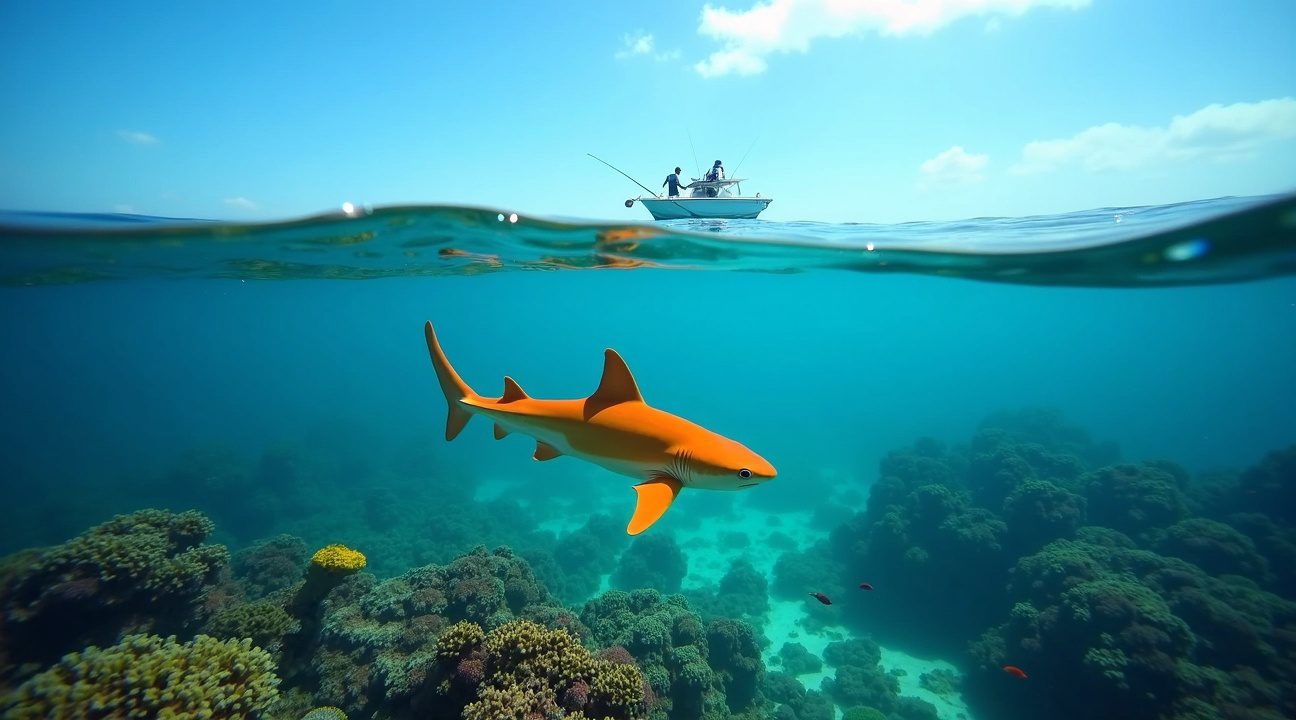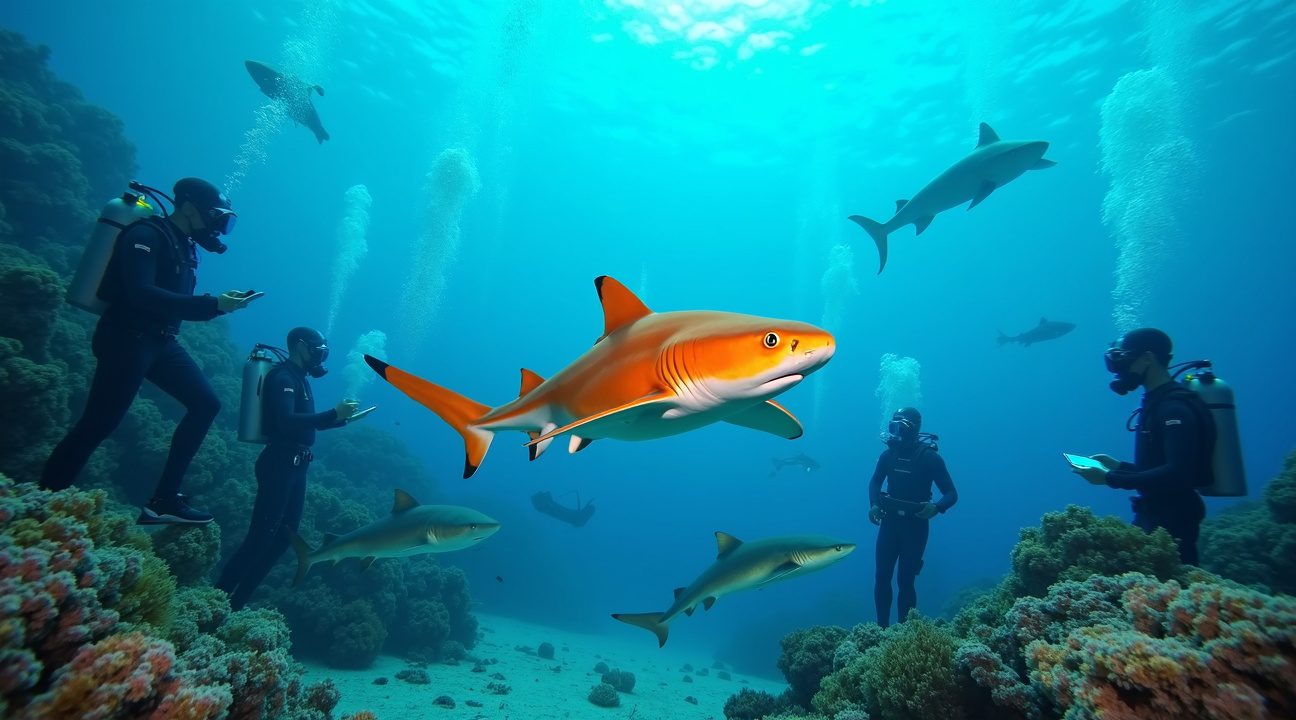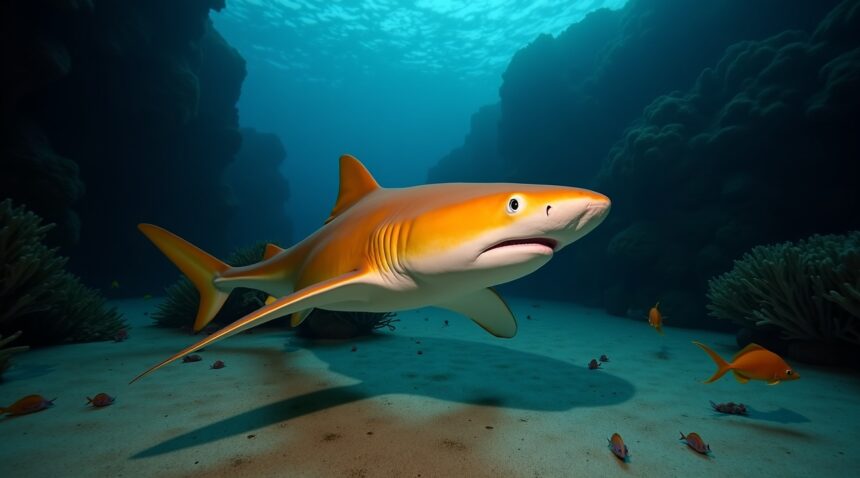Rare Albino-Xanthic Nurse Shark Discovered in Costa Rica’s Caribbean Waters
Scientists recently documented the first-ever nurse shark exhibiting bright orange coloration and completely white eyes near Tortuguero National Park, ushering in a groundbreaking discovery in marine biology.
This adult specimen, measuring approximately 6.5 feet, represents the first recorded case of albino-xanthism in cartilaginous fish. The unique genetic combination challenges what scientists understand about survival traits in highly visible marine predators.
Key Takeaways
- Unprecedented Genetic Combination: The nurse shark shows signs of xanthochromism (excess yellow/orange pigmentation) combined with albinism (absence of pigment in the eyes), marking an extraordinary case in shark research.
- Defying Expectations: Despite its vibrant and conspicuous look, the shark appeared healthy and well-nourished, questionning prior assumptions about the disadvantages of pigmentation anomalies among predators.
- Citizen Science Value: The shark was found during a recreational fishing trip at a depth of 37 meters, showcasing how citizen contributions can enhance marine biology.
- Implications for Conservation: This observation indicates that genetic diversity in Caribbean nurse sharks might be broader than once thought, potentially affecting future conservation methods.
- Ethical Wildlife Handling: The specimen was ethically treated and safely released, proving that scientific research can proceed without harming rare marine creatures.
Scientific Significance of the Discovery
This discovery near Tortuguero National Park provides marine scientists with essential insights into unexpected genetic combinations. Albino-xanthism is not only rare but had never been documented in nurse sharks or any cartilaginous species until now.
Xanthochromism and Albinism Explained
Xanthochromism results in increased orange and yellow pigmentation, giving this shark its vivid coloration. Albinism, on the other hand, is characterized by the complete lack of melanin, as demonstrated by the shark’s white eyes. This dual expression of genetic mutations is virtually unheard of in marine wildlife.
Impacts on Shark Survival and Behavior
The shark’s unexpectedly healthy state suggests this genetic uniqueness may not impair its hunting abilities as previously assumed. Nurse sharks typically rely on camouflage when stalking prey, but this bright-colored individual challenges those evolutionary assumptions.
Importance of Collaborations Between Communities and Scientists
Discovered by a commercial fishing crew at considerable depths, this case highlights the importance of partnerships between recreational fisheries and scientific institutions. These spontaneous encounters often provide scientists with rare opportunities to study uncommon phenomena.
Implications for Genetic Diversity and Conservation Strategies
This observation broadens our understanding of genetic diversity in Caribbean nurse shark populations. Conservational strategies may need realignment to accommodate findings that indicate more extensive variability than previously understood.
Ethical Research and Future Monitoring
By observing appropriate wildlife handling protocols and releasing the shark quickly back into its habitat, researchers set a strong example for balancing scientific curiosity and animal welfare. Rare genetic contributors like this individual remain active within the ecosystem, enhancing species longevity.
Marine biologists plan to monitor this nurse shark using photo identification and ongoing documentation. These long-term efforts may reveal the ecological and reproductive impacts of such rare genetic conditions in wild populations, providing a deeper grasp of evolutionary trends in marine life.
Rare Orange Shark with White Eyes Captured Off Costa Rica
Scientists documented an extraordinary discovery in Costa Rica’s Caribbean waters when they encountered the first-ever nurse shark displaying a vibrant orange coloration paired with completely white eyes. The adult Ginglymostoma cirratum measured approximately 2 meters (6.5 feet) in length and was spotted near Tortuguero National Park during a sport fishing expedition at a depth of 37 meters.
This remarkable specimen represents the first documented case of xanthochromism in nurse sharks and marks an unprecedented finding among cartilaginous fish species throughout the Caribbean Sea. The condition, also known as xanthism, causes an overproduction of yellow pigments while reducing or eliminating other color pigments, resulting in the shark’s striking bright orange appearance.
Understanding This Pigmentation Anomaly
The discovery reveals characteristics that distinguish this condition from typical albinism. While albino creatures lack melanin entirely and typically display pink or red eyes due to visible blood vessels, this nurse shark exhibits fully white eyes alongside its vibrant orange skin. Marine biologists classify this specific combination as albino-xanthism, a rare genetic variation that affects pigment production in unique ways.
I find this discovery particularly significant because nurse sharks typically display brown or gray coloration that helps them blend with sandy ocean floors and coral reef environments. The orange pigmentation would make this individual highly visible to both prey and predators, potentially affecting its survival and behavior patterns. Research into similar pigmentation anomalies in other marine species, such as deep-sea discoveries, continues to reveal new insights about genetic variations in ocean ecosystems.
The capture occurred in waters known for their rich biodiversity, where marine researchers frequently study various species adaptations. Sport fishing crews working with local scientists have become valuable contributors to marine research, as their extended time on the water often leads to encounters with unusual specimens that might otherwise go unnoticed by the scientific community.
This nurse shark’s condition offers researchers fresh opportunities to study how genetic mutations affect survival strategies and social behaviors in cartilaginous fish. The specimen’s adult size suggests it has successfully adapted to life with this distinctive coloration, raising questions about how other sharks and marine life respond to such dramatic visual differences. Future studies may examine whether similar pigmentation anomalies exist in other Caribbean shark populations or if this represents a truly singular occurrence in marine biology.
Unprecedented Genetic Condition Creates Unique Appearance
The bright orange shark displays a fascinating combination of two distinct genetic conditions that rarely occur together in wild marine animals. Scientists identified the specimen as exhibiting both xanthism and albinism, creating what researchers describe as an albino-xanthism appearance. This dual condition produces the shark’s striking orange coloration paired with completely white eyes, making it an extraordinary discovery in marine biology.
Xanthochromism develops through genetic mutations that dramatically increase yellow and orange pigments in the skin. This condition can also result from environmental factors or specific dietary influences that affect pigment production. The mutation causes an overproduction of xanthophores, specialized cells containing yellow and orange pigments that normally exist in much smaller quantities in healthy sharks.
Rare Combination of Genetic Traits
The white eyes observed in this nurse shark indicate a complete absence of pigmentation characteristic of albinism. Finding both conditions in a single wild specimen represents an exceptionally rare occurrence that has captured the attention of marine researchers worldwide. Most documented cases of unusual pigmentation in sharks involve either leucism, partial albinism, or xanthism individually, but never this specific combination.
Nurse sharks typically display brownish skin tones that provide excellent camouflage against sandy sea floors and rocky substrates. This natural coloration allows them to remain virtually invisible while resting during daylight hours. The dramatic orange and white pigmentation observed in this Caribbean specimen creates the opposite effect, making the animal highly conspicuous against its natural habitat.
This increased visibility presents significant survival challenges for the affected shark. Predators can easily spot the bright orange coloration from considerable distances, potentially putting the animal at greater risk during feeding or migration activities. The condition also affects the shark’s hunting efficiency, as prey species can detect its approach more readily than they would with a normally pigmented individual.
The genetic mutations responsible for these conditions often impact more than just appearance. Scientists studying similar cases in other marine species have found that genetic variations can influence behavior and physiological functions beyond pigmentation. The white eyes may indicate reduced visual capabilities, though nurse sharks rely heavily on electroreception and chemoreception for navigation and feeding.
Research into such genetic anomalies provides valuable insights into marine biodiversity and adaptation mechanisms. Each documented case helps scientists better understand how environmental pressures and genetic factors interact to produce these remarkable variations in wild populations. The discovery of this unique specimen adds important data to ongoing studies of pigmentation disorders in cartilaginous fish species.

Scientific Breakthrough Challenges Survival Assumptions
This extraordinary discovery has forced researchers to reconsider long-held beliefs about color variation and survival in marine environments. The bright orange nurse shark’s healthy, fully-grown state directly contradicts scientific assumptions that conspicuous coloration would severely compromise a predator’s hunting success and overall survival rates.
Rethinking Pigmentation and Predator Success
The shark’s vibrant appearance should theoretically make it an easy target for larger predators while simultaneously alerting prey to its presence. However, the specimen displayed no signs of malnutrition, injury, or stress-related behaviors that scientists typically associate with disadvantaged marine animals. This finding suggests that marine ecosystems may be more adaptable to genetic variations than previously understood.
Scientists now question whether certain pigmentation disorders might actually provide unexpected advantages in specific environments. The Caribbean’s complex reef systems and varied lighting conditions could potentially offer unique hunting opportunities for distinctively colored predators.
Unprecedented Xanthochromism Documentation
Xanthochromism represents one of nature’s rarest genetic expressions, typically producing striking yellow or golden coloration in affected animals. This condition occurs through the following mechanisms:
- Overproduction of yellow pigments in skin cells
- Suppression of other color-producing compounds
- Genetic mutations affecting melanin distribution patterns
- Environmental factors triggering dormant pigmentation genes
Previous xanthochromism cases have been documented in parrots displaying brilliant golden plumage, canaries with intensified yellow coloring, and occasional reptiles like bright yellow snakes. However, no confirmed instances existed in nurse sharks or any Caribbean cartilaginous fish species before this sighting.
The condition’s extreme rarity makes this discovery particularly significant for understanding genetic diversity in shark populations. Marine biologists have spent decades studying pigmentation variations in fish species, yet comprehensive xanthochromism documentation remains limited to isolated cases across different animal classes.
Interestingly, the opposite condition called axanthism involves the complete absence of yellow pigments, creating pale or whitish appearances in affected animals. Both conditions occur through similar genetic pathways but produce dramatically different visual results. Deep-sea research has revealed that pigmentation variations often correlate with depth preferences and hunting strategies, though this Caribbean shark challenges those established patterns by thriving in relatively shallow waters despite its unconventional appearance.
Research Implications and Environmental Factors
The bright orange shark discovery has prompted researchers to examine the complex interplay between genetic mutations and environmental pressures in Caribbean marine ecosystems. This unusual pigmentation anomaly offers valuable insights into how nurse shark populations adapt to their surroundings and the factors that influence such dramatic physical variations.
Genetic Diversity and Evolutionary Adaptation
I find the genetic implications of this discovery particularly fascinating, as it suggests that nurse shark populations harbor more genetic diversity than previously understood. The team’s findings, published in a scientific journal by authors including Marioxis Macías-Cuyare, Gilberto Rafael Borges Guzmán, and Daniel Arauz-Naranjo, reveal potential mutation pathways that could affect pigment development in these marine predators. This discovery challenges existing assumptions about the genetic stability of Caribbean shark populations and opens new avenues for studying evolutionary adaptation in marine environments.
The research team emphasizes that such rare mutations might indicate broader genetic variations within local populations. These findings could influence how scientists approach conservation strategies, particularly when considering the genetic health of isolated or stressed shark communities.
Environmental and Physiological Influences
Beyond genetic factors, researchers have identified several environmental elements that might contribute to unusual pigmentation patterns in sharks. The investigation reveals that multiple factors could influence shark coloration, including:
- Inbreeding within isolated populations that concentrates rare genetic traits
- Environmental changes affecting hormone production and pigment development
- Temperature fluctuations that disrupt normal cellular processes
- Chemical pollutants or changes in water chemistry impacting biological functions
- Nutritional factors related to prey availability and diet composition
Scientists emphasize that understanding these environmental drivers requires extensive further investigation. The discovery connects to broader research about marine biodiversity patterns and how ocean conditions affect species development. Temperature variations, in particular, have shown significant influence on marine animal physiology, potentially affecting everything from growth rates to reproductive success.
The research implications extend beyond individual shark biology to encompass broader marine conservation policy. Understanding how environmental factors contribute to genetic expression in marine species helps scientists develop more effective protection strategies. This knowledge becomes increasingly critical as ocean conditions continue changing due to climate factors and human activity.
Studies of deep-sea fish and other marine species have shown similar patterns where environmental pressures influence physical characteristics. The orange shark discovery adds another piece to this growing understanding of how marine ecosystems shape the creatures within them, providing researchers with valuable data for future conservation efforts and species protection initiatives.

Ethical Wildlife Handling and Conservation Value
The discovery team demonstrated exemplary ethical practices throughout their encounter with this remarkable bright orange shark. After completing their photographic documentation and preliminary examination, researchers released the animal unharmed back into its Caribbean habitat. The shark swam away in apparent good health, showing no signs of stress or injury from the brief encounter.
This approach represents the gold standard for wildlife research ethics. Such careful handling protocols ensure that scientific discovery doesn’t come at the expense of individual animal welfare. The team’s decision to prioritize the shark’s wellbeing over extended study time demonstrates how modern marine research has evolved to balance scientific curiosity with conservation responsibility.
Conservation Through Citizen Science
Sport fishing expeditions like this one continue to prove their immense value for marine science and conservation efforts. These recreational outings often venture into remote waters where formal research vessels rarely travel, creating unique opportunities for discovery. Charter boat captains and experienced anglers serve as invaluable partners in marine research, acting as the eyes and ears of the scientific community across vast ocean territories.
The collaboration between recreational fishers and researchers has yielded numerous significant discoveries in recent years. Similar partnerships have led to documentation of whale migration patterns and rare species sightings. These findings contribute crucial data points that help scientists understand marine ecosystem health and biodiversity distribution patterns.
Conservation organizations increasingly recognize that engaging recreational fishing communities creates a powerful network of citizen scientists. Anglers spend countless hours observing marine life in their natural habitats, often noticing unusual behaviors or rare species that might otherwise go undetected. This bright orange shark discovery perfectly illustrates how chance encounters during recreational activities can contribute to our understanding of marine biodiversity.
The genetic implications of this discovery extend far beyond a single unusual specimen. Maintaining genetic diversity within shark populations remains critical for species resilience and long-term survival. Color variations like this orange specimen suggest healthy genetic expression within the population, indicating that the species retains sufficient genetic flexibility to adapt to changing environmental conditions.
Marine biologists emphasize that genetic diversity acts as an insurance policy against environmental pressures and climate change impacts. Populations with greater genetic variation possess enhanced abilities to survive disease outbreaks, temperature fluctuations, and other ecological challenges. This principle applies equally to deep-sea species and shallow-water sharks alike.
The discovery also highlights the importance of protecting Caribbean marine ecosystems where such genetic diversity can flourish. Healthy ecosystems support the complex breeding patterns and habitat requirements necessary for maintaining diverse genetic lineages. Conservation efforts that preserve these environments directly contribute to sustaining the genetic health of marine species populations.
Research initiatives that combine recreational fishing activities with scientific observation protocols create win-win scenarios for both conservation and sport fishing communities. Anglers gain deeper appreciation for marine ecosystems while contributing valuable data to conservation efforts. Scientists access remote locations and receive real-time reports from experienced ocean observers who spend significant time in marine environments.
The documentation process itself demonstrates how modern technology enhances these collaborative efforts. High-quality underwater photography and GPS location tracking allow researchers to build comprehensive databases of rare species encounters. This information proves invaluable for understanding species distribution patterns and identifying critical habitat areas that require protection.
Future conservation strategies will likely rely increasingly on these citizen science partnerships. As professional research budgets face constraints, the volunteer contributions from recreational fishing communities become even more valuable. The bright orange shark discovery serves as a perfect example of how chance encounters, when properly documented and reported, can advance our understanding of marine biodiversity and inform conservation priorities.
The successful release and apparent health of this unique specimen also reinforces the effectiveness of catch-and-release practices in recreational fishing. These methods allow for scientific documentation while ensuring that rare or unusual specimens can continue contributing to their populations’ genetic diversity through future reproduction opportunities.

Future Research Directions for Marine Biodiversity
Scientists are calling for expanded monitoring programs to track pigmentation anomalies across Caribbean marine ecosystems. This unusual discovery highlights the need for systematic documentation of genetic variations that may provide crucial insights into how marine species adapt to changing environmental conditions. Research teams recognize that understanding these rare occurrences could reveal important patterns about genetic diversity and species resilience.
The bright orange nurse shark with white eyes represents just the beginning of what researchers hope will become a comprehensive study of genetic mutations in cartilaginous fish. Scientists plan to examine survival rates and behavioral patterns in sharks displaying unusual pigmentation to determine whether these conditions affect their ability to hunt, mate, or avoid predators. Early observations suggest these individuals may face unique challenges in their natural habitat, making long-term monitoring essential for understanding their life outcomes.
Expanding Research Across Caribbean Populations
Research initiatives will focus on several key areas to maximize scientific understanding:
- Genetic sampling from nurse shark populations throughout the Caribbean to identify mutation frequency
- Behavioral analysis comparing affected individuals to typically pigmented sharks
- Environmental factor assessment to determine potential triggers for genetic anomalies
- Population health monitoring to track long-term survival rates
- Photographic documentation to create a comprehensive database of pigmentation variations
Marine biologists are particularly interested in investigating whether similar cases exist in other nurse shark colonies across the region. This research could reveal whether environmental factors such as water temperature, pollution levels, or habitat changes contribute to increased mutation rates. Scientists studying deep-sea fish populations have noted that extreme conditions often lead to unique adaptations, suggesting that Caribbean waters may harbor more genetic diversity than previously understood.
The discovery also opens possibilities for comparative studies with other marine species showing unusual characteristics. Researchers examining cephalopod evolution have found that genetic variations often provide valuable insights into broader ecosystem health. By studying pigmentation anomalies across multiple species, scientists hope to develop better indicators for monitoring marine biodiversity changes in response to climate shifts and human activities.
Future expeditions will employ advanced genetic sequencing techniques to identify the specific mutations responsible for these dramatic color changes. This molecular approach could help scientists predict which shark populations might be most susceptible to similar variations and whether these traits could be passed to future generations.

Sources:
The Tico Times – Costa Rica Anglers Catch Rare Orange and Albino Nurse Shark
The Independent – Extremely rare orange shark discovered off Costa Rica
The Daily Galaxy – First-ever Sighting Of A Bizarre Orange Shark With Eerie White Eyes


